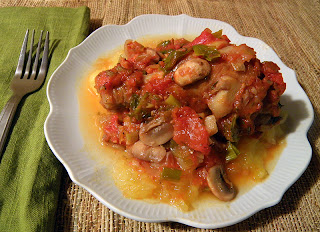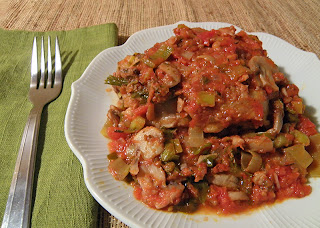 |
| Add Chicken to Sauce and Simmer |
Recipe by Robin
Chicken Marengo. I’d heard the name for years, but never
realized that it’s a historical dish. Napoleon Bonaparte’s chef Dunand first
whipped it up after Napoleon’s victory at the Battle of Marengo in northern
Italy in 1800. Using miscellaneous foraged ingredients, Dunand employed
considerable skill in crafting the original recipe using chicken, eggs,
tomatoes, onions, garlic, and crayfish, plus a couple of glugs of cognac from
Napoleon’s flask. The result was a
chicken-tomato-onion stew served with fried eggs, crayfish, and soldiers’ bread
rations on the side. Although this sounds like it would only taste good if you
were camping, Napoleon considered the combination lucky. He insisted that
Dunand prepare it the same way time and again when they returned home, despite
the chef’s desire to modify the ingredients. Fortunately modern chefs are no
longer literally under the sword, and have reinvented the recipe minus the eggs
and crayfish and plus a few classic ingredients from Italian cuisine.
 |
| With Spaghetti Squash: Nontraditional & Low Carb |
 |
| Vary Sauce Herbs as You Like |
 |
| Flavors Blend &Develop during Simmering |
Have fun with this by using whatever herbs and veggies you
like in a tomato stew. Please share a comment if you come up with a variation
that you like.
serves 6 - 8
3½ lbs. chicken legs
½ cup all purpose flour
~½ tsp. salt
~¼ tsp. pepper
1½ tbsp. olive oil
1 lb. mushrooms, thinly sliced
2 shallots
1 medium bunch leeks
4 cloves garlic
1 tbsp. olive oil
~5 ½ cups stewed
tomatoes, OR 3 - 14.5 oz cans diced tomatoes
½ cup dry white wine
2 tbsp. tomato paste
1 tsp. dried thyme
½ tsp. dried oregano
¼ tsp. salt or to taste
1/8 tsp. pepper
½ - 1 cup packed Italian parsley leaves
Separate chicken thighs from drumsticks. Remove any excess
fat. Combine the flour with ½ teaspoon of salt and ¼ teaspoon pepper in a large
ziplock bag. Add chicken pieces to bag, 2 at a time, zip up bag, and shake
until chicken is coated with flour. Shake off excess flour and put chicken
pieces in a single layer on a plate.
Heat an electric
frying pan to 400 degrees F., or heat a large skillet over medium high.
When hot, add 1½ tbsp. olive oil and fry chicken parts until light brown, about
10 - 15 minutes, turning frequently. You might want to use a grease
screen to cut down on splatters.
While chicken is cooking, remove roots from leeks and slice
lengthwise from top to bottom. Wash thoroughly. Slice only white and light
green parts into ~3/8 inch half moons, discarding tough green parts. You will
have 2 - 3 cups.
Peel and chop shallots finely. Slice mushrooms thinly (<
¼ inch). Peel and mince garlic.
When chicken is brown, remove from frying pan and drain on
towel. Blot oil from top of chicken. Drain excess oil from frying pan, but
leave browned bits in pan.
Add 1 tbsp. olive oil to pan and return to medium high heat
(375 - 400 degrees F.) Add
shallots and mushrooms and sauté for about 4 minutes, stirring frequently. Add
leeks and garlic and continue sautéing and stirring for another 4 minutes.
Stir in stewed tomatoes, wine, tomato paste, thyme, oregano,
salt, pepper, and parsley until all ingredients are blended. Bring to boil and
simmer together 5 minutes.
Add browned chicken to frying pan, nestling pieces down into
the sauce. Spoon sauce over the top of the chicken pieces. Bring sauce back to
boil.

No comments:
Post a Comment